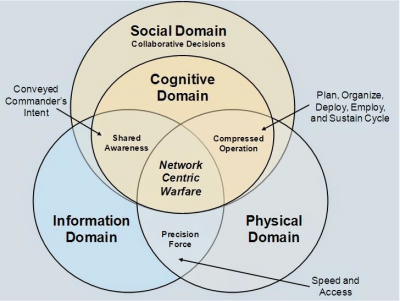Recently, China accused the US of employing cognitive warfare when a photograph emerged of two US naval officers unflappably watching a Chinese aircra
Recently, China accused the US of employing cognitive warfare when a photograph emerged of two US naval officers unflappably watching a Chinese aircraft carrier in the South China Sea. Experts interpreted it as signalling to China that the US is “watching“. China itself has been accused of utilising cognitive warfare during the Covid-19 pandemic against Taiwan and other Western countries. China’s focus has also evolved from informatization to intelligentization, which was outlined in its 2019 Defense White Paper and is slated to become the “prevailing form of war“. China has been working on intelligentized technologies and operational concepts.
There are multiple challenges that are being brought forth by the weaponization of the cognitive domain by various countries. Cognitive warfare signals a shift away from conventional military parity and diffusion of warfare. The era of mass customization of various modes of online communication and information has dawned. In this environment, cognitive warfare is executed through the utilization of different platforms, including social media, where messages, beliefs, views, and narratives can be influenced, persuaded, and altered for cognitive advantages, without having to resort to outright force or coercion.
Cognitive Warfare
The speed and the extent of information propagation have been tremendously boosted by technological innovations and advancements. This can have a massive impact on the geopolitical landscape of the world without initiating kinetic military warfare. As such, both state and violent non-state actors are employing the technology and psychology understanding to wage cognitive warfare on nations that might not even be prepared for such tactics and their magnitude. Consequently, countering cognitive warfare requires organizationally innovative action, which is backed by a persistent change in face of evolving technologies.
Cognitive Warfare has transformed the concept of ‘below the threshold’ conflict and is at the critical juncture of becoming the norm. The trust which is the linchpin of a country’s “strategic strength” can be negated using cognitive warfare with minimal utilization of resources, while results are maximized. Successful manipulation of asymmetrical methods and unconventional means encompassing non-kinetic and non-lethal delivery, propagated through digital avenues, have removed the epicentre of political battle from armed war to a narrative war contested in the minds of the public. Cognitive warfare can also be waged for the explicit purposes of nurturing apprehensions regarding governance, subverting democratic processes, triggering civil disturbances, or instigating separatist movements. This is done through reinforcing cognitive biases, innate reasoning, and critical incident decision-making fallacies.
Cognitive warfare has been defined as a “disinformation process to psychologically” and gradually weaken the recipients of the information, thus directing public discourse. This is done to manufacture cracks in societal harmony and to damage confidence in institutions. The information is purposefully propagated and amplified through social media, fake news, online platforms, leaks, videos, politically sensitive information, as well as photographs altered to be “out of context and political cartoons”, for the purpose of acquiring a competitive edge over the adversary. The target viewers can then espouse the stance being propagated to further strategic or operational objectives of the actors engaging in cognitive warfare more effortlessly and unknowingly. Cognitive warfare is also the weaponization of “techno-social engineering” which examines the processes wherein technologies and societal influences sway thoughts, perceptions, and actions.

The Emergence of Cognitive Warfare
Cognitive doctrine is exemplified in the Russian Gerasimov Doctrine, where the goal is to cultivate perpetual strife and turmoil to weaken the enemy state from within. Moreover, artificial intelligence and its incorporation in complicated anthropological structures, which aim for behavioural intercessions, can further aggravate these concerns. However, countering cognitive warfare is made explicitly more difficult due to challenges, such as cognitive warfare possessing a significantly lower threshold, being considerably harder to detect and deter with the capacity to easily surge across intertwined systems, exacerbated by low investment in protecting data integrity and restoring it. Moreover, contemporary asymmetric conflicts with no clear victors and methods have made the narrative building paramount.
Haphazardly regulated areas of the cyber domain can result in these technologies and skills being sold to the highest bidders, be they state actors or violent non-state actors. This proliferation can then lead to an increase in cognitive warfare, which will further strain the infrastructure and expand distrust in institutions with an inability to counter or deter tactics in cognitive warfare, likely resulting in a vicious cycle. Furthermore, below the threshold conflict, owing to the emerging cognitive combat zone has transmuted to require more than just the strengthening of non-lethal capacities of states to contain it, as it possesses the potential to transform into a conventional war. To fight on the cognitive battlefield requires constant, “hyper-competitive, multi-domain” struggle while managing flexibility as well as volatility. This additionally necessitates preserving consistency of tactical, non-intuitive, and strategic aims while thwarting unrelenting strikes.
The Power of Technology
Technology continues to alter human bodies and minds, including memory, interests, attention and sleep cycles. The advent of brain stimulation devices, brain-machines, and interfaces aided by machine learning have led to the exploration of intricate forms of movements in a brain when considering a particular figure, reading, even a distinct emotion or discovery of new information. Through this information, researchers can better understand cognitive functions, such as the distinction between cognitive fortes and limitations of individuals, and identify certain views, perceptions and emotions, as well as the misrepresentation of motives and values. This better understanding can then be utilized to cut off “historical memory”, so that victims will be receptive to new beliefs, focusing on leaders to shift their ideological pivots; “deconstructing symbols” to question national identity. These new developments can give enormous leverage to the adversary or can be misdirected to be used to incite allies of the adversary.
Russia employs information operations to provoke internal schisms within the Baltic countries which destabilize politics and undermine institutions, for instance by casting doubt on voting results. Furthermore, democratic countries are most vulnerable during elections; as such, cognitive warfare empowered by other Russian cyber capabilities amassed at the time of elections can effectively disrupt elections. The cognitive battlefield is strewn with propaganda and misinformation to consistently set a context, including “instrumentalization of historical memory”, assertions of the negation of Baltic states’ functioning, while playing up to the cultural and linguistic heritage of Russia to gain an upper hand. These developments have resulted in the conceptualisation of the Primakov doctrine, whose aims include a multipolar world order, cooperation with China, Russian domination in the post-Soviet space, and putting up opposition to NATO enlargement while ensuring the indispensability of Russia in the global order. The Primakov doctrine also involves a strategy to pre-empt political backlash to Russian initiatives, which may culminate into large scale implementation of cognitive warfare.

Cognitive Warfare is predicted to target cognitive, physiological and behavioural vulnerabilities
In a different sphere, perceptions of technology as “just tools” in governmental institutions contradicts the users of these technologies, who encounter technologies as carriers of significance, inspirations, and “extensions” of those users. This disengagement between understanding emotional attachment, which is likely to increase, with a surge in interaction and the level of emotional connection makes exploiting citizens of an adversarial country markedly easier. Instead of being prepared, the surprise element of the warfare is undoubtedly enhanced. Cognitive warfare preys on and intends to, persuade a rival to let down their guard and make room for complacency, which can then be exploited. The “semantic memory” becomes predisposed to manipulations as well.
Countering Cognitive Warfare
Henceforth, to counter cognitive warfare, non-partisan and unbiased institutional frameworks are required. These intuitions should be enabled to scrutinize, supervise, and verify the veracity of election results and the election process. Political parties and campaigns must be expected to allot resources towards cybersecurity and for cyber literacy so politically sensitive information cannot be used for cognitive warfare. Additionally, laws, such as the Cybersecurity Information Sharing Act, empower private industry to share information with the government without being deprived of a competitive edge or being embroiled in legal quagmires, which can lead to a more robust cognitive security environment.
Two divisions of cognitive influencing technologies can be utilized for cognitive warfare. The first is related to the capability to think and functionality through cognitive surveying, interference and strengthening technologies. The second is subliminal cognition that focuses on technologies that influence basic emotions, beliefs awareness, and drive through processing, implanting, and detecting technologies. Furthermore, negative cognitive exertions prevent the development of undesirable cognitive conditions while positive cognitive efforts yield a preferred awareness.
Evolution in technology also leads to the evolution of vulnerabilities including cognitive susceptibilities. This is aggravated by the progressively falling cost of the technology which permits different actors to penetrate the sphere where state actors are swayed by “legal and policy” concerns, giving impetus to instability. This is further exacerbated by the erosion of diplomatic power of countries due to the narratives proliferated through cognitive warfare, which question the legitimacy of governments and the supportive institutional framework. To maintain stability and trust in institutions, positive messages which reinforce fundamental societal values and principles have proved to be effective.
Cognitive warfare integrates cyber, information, psychological, and social engineering capabilities to achieve its ends. This has highlighted a fundamental disconnect between countries that utilize cognitive warfare, such as Russia, which perceive themselves perpetually positioned to be engaged in information warfare, while the West views the engagement as only temporary. This perception affects resource allocation, collaboration, expanding adaptability through feedback and follow-through on operations.

The Cognitive Domain
The cognitive security framework must take these differences into account when forming mechanisms for countering cognitive warfare. Moreover, the underlying conditions which might be societal, political, and economic may act as facilitators and, as such, cannot be ignored while constructing institutional frameworks. However, hurried counter-cognitive actions may prove similarly detrimental as the extent of collateral damage can be enormous. Immense consideration is required to discern external interference and meddling from valid, genuine, and guarded freedom of speech of political actors within the country itself. Authenticity and credentials must be properly and thoroughly checked to discredit the adversary before launching counter-cognitive action, as escalation is an extremely likely scenario. The outcomes are incremental, and it is challenging to gauge their impact. However, there have been reports of situations when inaction was disadvantageous to societal resilience.
As the world becomes multipolar, the rising powers are likely to pursue strategies that will confront the capabilities of rival nations to counter. Cognitive warfare may just be the start of a new era of confrontation and competition, as well as of “cumulative gains”. Cognitive warfare is rewriting presumptions of contemporary warfare while the potent mixture of technology, insight into human psychology, and the calculated motivation to employ these judiciously at unparalleled speeds is likely to be lethal.
- Why are states increasingly more susceptible to cognitive warfare?
- How are adversarial countries employing cognitive warfare to achieve cumulative gains?
- What are the strategies and tactics to counter cognitive warfare?
Fonte: The New Global Order


